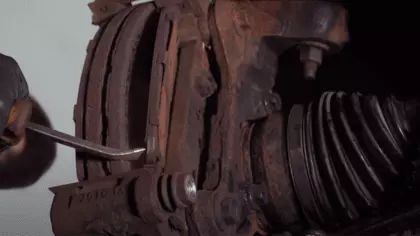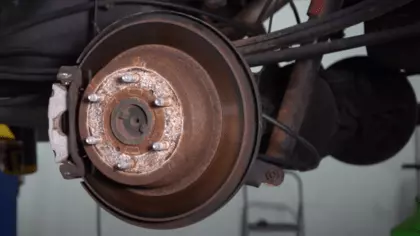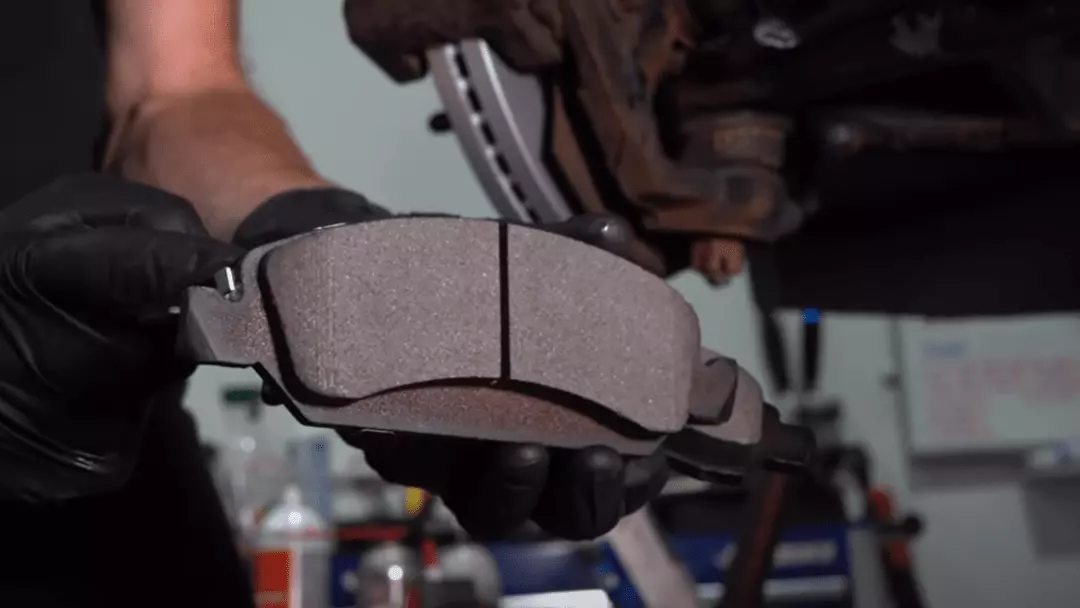You must be familiar with the braking system, which is a component of disc brakes used in automobiles. Recently you decided to change the brake pad of a GMC Sierra but you have no knowledge about how to change brake pads on a GMC Sierra 1500. Even after checking the manual, you’re confused about the process of changing the brake pad! What should you do now?
You can follow DIY steps or by taking the help of some tools. You can do it yourself or with the help of various tools. Usually, we begin by loosening but not removing the wheel nuts. Then, jack up the car using the suitable point jack and jack stand.
However, reading the entire article will share more details on GMC Sierra brake pad replacement. Changing the brake pads won’t require much trouble just having a little mechanical knowledge, a few tools, and spending a little time will complete the job.
Contents
- 1 How Long do Brakes Last on a GMC Sierra 1500?
- 2 How Do I Know If I Need to Replace My Brakes – 6 Signs to Check
- 3 What Happens If You Wait Too Long to Change Brake Pads?
- 4 Can You Drive a Car with Worn Brake Pads?
- 5 How Difficult is it to Replace Brakes On a Car?
- 6 How to Change Brake Pads On a GMC Sierra 1500 – Things to Know
- 7 How do you change your brake pads – Front and Rear Brake Pads Replacement
- 8 How Long Does it Take to Change Brake Pads on a Truck?
- 9 How Much Does it Cost to Replace Brakes on a GMC Sierra?
- 10 Frequently Asked Questions
- 11 Final Words
How Long do Brakes Last on a GMC Sierra 1500?

Basically, how much the brake pad will stay depends on a lot of things such as where and how you drive, vehicle type, plus the material of your brake pads. when it comes to the previous and most recent model 2022 GMC Sierra 1500, the brake pad may last around 30k to 70k miles. Also, you should be aware of the facts that may reduce the durability of your vehicle’s brakes.
- Whenever you brake hard on your Souris roadways, there is a possibility of dulling the brake pads.
- Make sure you always choose carbon ceramic pads that last longer than metallic pads.
- Since you might have to drive on a busy road, encounter traffic, or face stops signs, you have to choose to brake frequently which ultimately decreases the lifespan of your GMC brake.
How Do I Know If I Need to Replace My Brakes – 6 Signs to Check

Your GMC car tries to show some signals to let you know about the trouble. However, GMC brake pad replacement is required if you notice the given signals.
- Parking the car takes extra time.
- You’ll notice the brake pad indicator light illuminates and becomes thin.
- If it’s about a GM vehicle, you’ll detect scraping noise from the metal tables hitting the vehicle rotor just before losing all the brakes in a couple of hundred miles.
- Sometimes the worn-out brakes begin squealing like fingernails.
- Whenever your brake, your vehicle’s nose slides to one side.
- Once the brake pedal is pressed, it vibrates.
What Happens If You Wait Too Long to Change Brake Pads?
Riding with worn brake pads can lead to risky driving situations. When a brake pad starts to break down, the bolt heads that secure the pad backing to the calipers become disclosed and begin scoring grooves into rotors.
Sometimes, the rotors shatter into two parts and are considered a total failure. Taking the car to be repaired immediately could have cost $40 pads, but the entire system needs $1000 or more in braking parts.
Can You Drive a Car with Worn Brake Pads?
Yes, you can ride but you run the chance of an accident, as well as destroying the entire brake system. If you ask is it illegal to drive with worn brake pads? we would say yes it’s not legal according to us since it carries risk.
However, Brake pads must be changed per 25,000 – 65,000 miles on average. Rotors, on the other hand, must be changed per 30,000 – 70,000 miles.
Also Read: best brake pads for Chevy Tahoe
How Difficult is it to Replace Brakes On a Car?
Mainly, you should consider the vehicle type, brake kinds, whether four-wheel disc, type of parking brake, tools you have, brake caliper as well as wheel cylinders functioning flexibly and not leaking. Also, think about the facts about whether brake discs or drums require machining.
In general, Brake replacement is one of the simplest DIY car maintenance projects. We have a DIY process waiting for you down below. It is simple to replace braking systems, but you should work methodically. If you have zero knowledge, obtain a workshop manual to learn how everything works. A professional mechanic can probably replace your brakes in a few hours.
How to Change Brake Pads On a GMC Sierra 1500 – Things to Know

We would like to present the DIY method of changing the brake pads of the GMC Sierra. For getting the steps, you have to go through the next section.
Can I Replace My Brake Pads Myself?
Yes, the DIY method is the best way to change the brake pad. It would be much better if you check the owner’s manual for the instructions.
Tools for Changing GMC Sierra Brake Pads
Just before you start the GMC Sierra brake upgrades, make sure you have all the tools that we are sharing below.
- Brake rotors and pads
- Bolts
- Wire brush
- Big C-clamp
- The screwdriver which is a flathead
- Hydraulic Jack plus jack stands
- 18 to 22mm ratchets and sockets
- Breaker bar or pipe
- Brake lubricant
- Adjustable wrench or lug nut wrench
- Mechanic’s gloves.
How do you change your brake pads – Front and Rear Brake Pads Replacement
We will share how we usually change the front and rear brake pads. So, before we make further late, let’s have a look at the GMC Sierra brake line replacement.
How to Change Front Brake Pads on a GMC Sierra 1500 – 10 Steps to Follow

While changing the front brake pads, it’s about replacing the brake pads and rotors. Just before doing this job, get brake pads, rotors, cleaner, disk spreader set, and some other tools. However, the changing brake pads steps are:
- First, extract the wheel.
- Release the sliding bolt.
- Pivot the caliper.
- Take the damaged brake pads.
- Rebuild the holding clips.
- Change the brake pads.
- Retract the pistons.
- Verify your brake fluid level.
- Readjust the caliper and mount the sliding bolt.
- Try a test drive.
How to Change Rear Brake Pads on a GMC Sierra 1500 – 8 Easy Steps
We have some step-by-step ways to alter the back brake pads. Therefore, what you should are:
- First, remove the back or rear wheel.
- Take the bolts from the caliper pins and brackets.
- Lubricate the caliper guide pins.
- Take off the brake pads.
- Replace the caliper bracket.
- Attach the new brake pads.
- Remount your wheel and re-attach the caliper.
- And activate the brake pedal.
How Long Does it Take to Change Brake Pads on a Truck?
If you hand your car to the expert, they can change the brake pads in 30 minutes or 1 hour at best. But for the beginner with zero experience in mechanical jobs, it will take more like around 2 hours.
How Much Does it Cost to Replace Brakes on a GMC Sierra?
The GMC Sierra 1500 brake pad replacement costs around 331 to $361 on average. Most probably, the labor charge will include withing 114 to $144 and parts include $217. But replacing the brake pad by yourself will only require 50 to $100 per brake pad.
Frequently Asked Questions
Is $600 too much for front brake pads and rotors?
A professional mechanic will take 3 to 4 hours to reinstall the bearing in the pads and rotor for 600 dollars. they also integrate a brake fluid adjustment.
However, it can also be called a high amount of repairing the GMC Sierra 1500 brakes, therefore, you can try to negotiate the price a little by selecting the mid-level brake parts rather than the premium one the repairer chooses. Or if you have DIY knowledge, you can save a lot of money.
Do front brakes wear faster than rear?
Usually, heat, friction, and weight transfer cause the brake wears out faster over time. And front brake pads possibly get damaged or become faulty faster than the rear ones particularly due to deterioration.
How do you make brake pads fit perfectly in your caliper?
We have easy steps to make the brake pads fit properly in the caliper. Therefore, what you need to do is:
1. Choose the appropriate pads for the vehicle.
2. Stop using petroleum-based lubrication on the rubber bushings since it will expand or ruin the rubber.
3. Anchor bolts for saddles and guidance pin bolts must be cleaned and re-installed.
4. Also, you can free up the caliper body on your support pins by pushing the piston.
Final Words
Whether you have to change the front or rear brake pads, we have included the easiest steps that you should follow. If you find any signals from the GMC Sierra like odd noise, slow progress, a light illuminating, or vehicle vibration, just take it to the mechanic or try the Diy process about How to Change Brake Pads On A GMC Sierra 1500.
One more thing to give importance to is the tools that you need. Grab your tools, and replace the vehicle brake pads with your hand rather than investing a huge amount for repairing and replacing them.

Hello, this is Wesley Shelton, currently working in a car restoration company for over 5 years. Before that, I was a worker at a small car repair shop. As I was a car freak from a young age and worked as a professional for over half a decade, I think I now know pretty much everything about every car and its parts. To establish my name as a professional and help others by sharing my knowledge, I’ve created this website, which I work on whenever I get free time. I hope you’ve enjoyed my informative blog!

